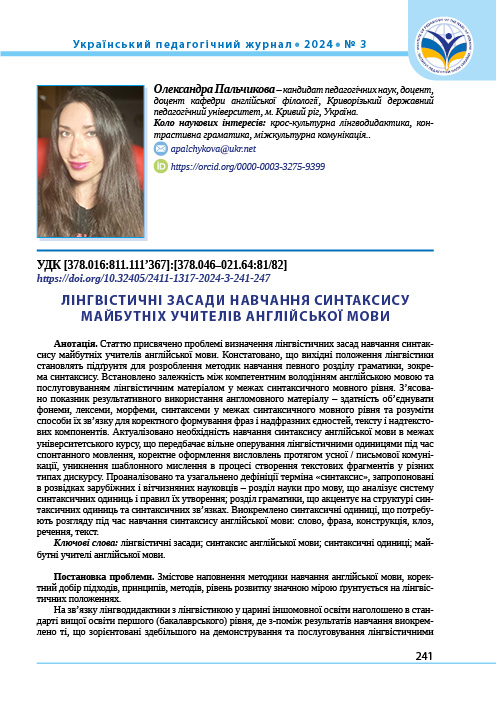Анотація
Статтю присвячено проблемі визначення лінгвістичних засад навчання синтаксису майбутніх учителів англійської мови. Констатовано, що вихідні положення лінгвістики становлять підґрунтя для розроблення методик навчання певного розділу граматики, зокрема синтаксису. Встановлено залежність між компетентним володінням англійською мовою та послуговуванням лінгвістичним матеріалом у межах синтаксичного мовного рівня. З’ясовано показник результативного використання англомовного матеріалу – здатність об’єднувати фонеми, лексеми, морфеми, синтаксеми у межах синтаксичного мовного рівня та розуміти способи їх зв’язку для коректного формування фраз і надфразних єдностей, тексту і надтекстових компонентів. Актуалізовано необхідність навчання синтаксису англійської мови в межах університетського курсу, що передбачає вільне оперування лінгвістичними одиницями під час спонтанного мовлення, коректне оформлення висловлень протягом усної / письмової комунікації, уникнення шаблонного мислення в процесі створення текстових фрагментів у різних типах дискурсу. Проаналізовано та узагальнено дефініції терміна «синтаксис», запропоновані в розвідках зарубіжних і вітчизняних науковців – розділ науки про мову, що аналізує систему синтаксичних одиниць і правил їх утворення; розділ граматики, що акцентує на структурі синтаксичних одиниць та синтаксичних зв’язках. Виокремлено синтаксичні одиниці, що потребують розгляду під час навчання синтаксису англійської мови: слово, фраза, конструкція, клоз, речення, текст.
Посилання
Бігич, О., Бориско, Н., Борецька, Г. (2013). Методика навчання іноземних мов і культур: теорія і практика. Київ: Ленвіт.
Гладуш, Н., Павлюк, Н. (2019). Contrastive Grammar: Theory and Practice = Порівняльна граматика: теорія і практика. https://ekmair.ukma.edu.ua/handle/123456789/15739
Селіванова, О. О. (2008). Сучасна лінгвістика. Київ-Полтава: Довкілля-К. https://archive.org/details/selivanova2008/page/2/mode/1up
Міністерство освіти і науки України. (2024).Стандарт вищої освіти України перший (бакалаврський) рівень, галузь знань 01 Освіта/Педагогіка, спеціальність 014 Середня освіта (за предметними спеціальностями).
Abdullah. (2023). English syntax. Badan Penerbit UNM. http://eprints.unm.ac.id/28397/1/BUKU%20ENGLISH%20SYNTAX%202022.pdf
Amanov, A. (2023). Examining a complex syntactic structure as a linguistic text unit. Zamonaviy dunyoda ilm-fan va texnologiya, 2(15), 16–18 https://doi.org/10.5281/zenodo.7907262
Ancheta, R., Simagala, E. (2017). Grammar errors in written composition of selected level 3 students of Gulf College: Basis for remediation. International Journal of English Research, 3(2), 63–67.
Aryanti, M. (2017). The relation among syntactic units, tenses and meanings in students’ writing. In Proceedings of the 1st English Language and Literature International Conference (ELLiC) (pp. 141–144). Semarang, Cetral Java, Indonesia. https://jurnal.unimus.ac.id/index.php/ELLIC/article/view/2460/2484
Babikir, A. (2018). English Syntax as a Source of Problems Encountered by EFL University Students in Translation from English into Arabic [Doctoral dissertation, University of Gezira]. http://repo.uofg.edu.sd/bitstream/handle/123456789/3109/Abdel-%20MonimIdrissBabikir.pdf?sequence=1&isAllowed=y
Croft, W. (2003). Typology and Universals. London: Cambridge University Press.
Cunningham, U. (2015). Language teachers’need for linguistics. Linguistic Society of New Zealand, 58, 77–94. http://www.diva-portal.org/smash/get/diva2:1236535/FULLTEXT01.pdf
Junaid, J. (2018). А syntactic analysis of the English noun phrase (A study at the fifth semester of English department faculty of teacher training and education university of Muhammadiyah Makassar). Journal Pengembangan Sumber Daya Insani, 3(1), 317–326.
Kim, J., Sells, P. (2007). English Syntax: An Introduction. Centre for the Study of Language and Information.
Koeneman, O., Zeijlstra, H. (2017). Introducing syntax. London: Cambridge university press. https://www.book2look.com/book/9781107096745
Koroliova, V, Popova, I. (2020). The syntactic unit (from definition to modelling). Ukrainian sense, 1, 39–53. https://doi.org/10.15421/462005
McRoy, S. (2021). Principles of Natural Language Processing. Milwaukee. https://uwm.pressbooks.pub/naturallanguage/
Miller, J. (2002). An introduction to English syntax. Edinburgh University Press. https://perpus.univpancasila.ac.id/repository/EBUPT170002.pdf
Μήτσης, Ν. (2004). Διδακτική του γλωσσικού μαθήματος. Από τη γλωσσική θεωρία στη διδακτική πράξη. Gutenberg.
Veliyeva, F. M. (2021). About the syntactic constructions and features of the aphorisms used in Azerbaijan language. Вісник університету Альфреда Нобеля. Серія “Філологічні науки”, 1(21), 122–130.
Yaseen, A., Ismail, K., Yasin, M. (2018). Syntactic Errors in an Arab EFL Postgraduate Student’s Spoken English during a Thesis Supervision Session. Arab World English Journal (AWEJ), 9(4), 392–406. https://dx.doi.org/10.24093/awej/vol9no4.29
Abdullah. (2023). English syntax. Badan Penerbit UNM. http://eprints.unm.ac.id/28397/1/BUKU%20ENGLISH%20SYNTAX%202022.pdf (in English).
Amanov, A. (2023). Examining a complex syntactic structure as a linguistic text unit. Zamonaviy dunyoda ilm-fan va texnologiya, 2(15), 16–18 https://doi.org/10.5281/zenodo.7907262 (in English).
Ancheta, R., Simagala, E. (2017). Grammar errors in written composition of selected level 3 students of Gulf College: Basis for remediation. International Journal of English Research, 3(2), 63–67. (in English).
Aryanti, M. (2017). The relation among syntactic units, tenses and meanings in students writing. . In Proceedings of the 1st English Language and Literature International Conference (ELLiC) (pp. 141–144). Semarang, Cetral Java, Indonesia. https://jurnal.unimus.ac.id/index.php/ELLIC/article/view/2460/2484 (in English).
Babikir, A. (2018). English Syntax as a Source of Problems Encountered by EFL University Students in Translation from English into Arabic [Doctoral dissertation, University of Gezira]. http://repo.uofg.edu.sd/bitstream/handle/123456789/3109/Abdel-%20MonimIdrissBabikir.pdf?sequence=1&isAllowed=y (in English).
Bihych, O., Borysko, N., Boretska, H. (2013). Metodyka navchannia inozemnykh mov i kultur: teoriia i praktyka. Kyiv: Lenvit. (in Ukrainian).
Croft, W. (2003). Typology and Universals. London: Cambridge University Press. (in English).
Cunningham, U. (2015). Language teachersneed for linguistics. Linguistic Society of New Zealand, 58, 77–94. http://www.diva-portal.org/smash/get/diva2:1236535/FULLTEXT01.pdf (in English).
Hladush, N., Pavliuk, N. (2019). Contrastive Grammar: Theory and Practice = Porivnialna hramatyka: teoriia i praktyka. https://ekmair.ukma.edu.ua/handle/123456789/15739 (in Ukrainian).
Junaid, J. (2018). A syntactic analysis of the English noun phrase (A study at the fifth semester of English department faculty of teacher training and education university of Muhammadiyah Makassar). Journal Pengembangan Sumber Daya Insani, 3(1), 317–326. (in English).
Kim, J., Sells, P. (2007). English Syntax: An Introduction. Centre for the Study of Language and Information. (in English).
Koeneman, O., Zeijlstra, H. (2017). Introducing syntax. London: Cambridge university press. https://www.book2look.com/book/9781107096745 (in English).
Koroliova, V, Popova, I. (2020). The syntactic unit (from definition to modelling). Ukrainian sense, 1, 39–53. https://doi.org/10.15421/462005 (in English).
McRoy, S. (2021). Principles of Natural Language Processing. Milwaukee. https://uwm.pressbooks.pub/naturallanguage/ (in English).
Miller, J. (2002). An introduction to English syntax. Edinburgh University Press. https://perpus.univpancasila.ac.id/repository/EBUPT170002.pdf (in English).
Selivanova, O. O. (2008). Suchasna linhvistyka. Kyiv-Poltava: Dovkillia-K. https://archive.org/details/selivanova2008/page/2/mode/1up (in Ukrainian).
Ministerstvo osvity i nauky Ukrainy. (2024). Standart vyshchoi osvity Ukrainy pershyi (bakalavrskyi) riven, haluz znan 01 Osvita/Pedahohika, spetsialnist 014 Serednia osvita (za predmetnymy spetsialnostiamy). (in Ukrainian).
Veliyeva, F. M. (2021). About the syntactic constructions and features of the aphorisms used in Azerbaijan language. Visnyk universytetu Alfreda Nobelia. Seriia “Filolohichni nauky”, 1(21), 122–130. (in English).
Yaseen, A., Ismail, K., Yasin, M. (2018). Syntactic Errors in an Arab EFL Postgraduate Students Spoken English during a Thesis Supervision Session. Arab World English Journal (AWEJ), 9(4), 392–406. https://dx.doi.org/10.24093/awej/vol9no4.29 (in English).
Μήτσης, Ν. (2004). Διδακτική του γλωσσικού μαθήματος. Από τη γλωσσική θεωρία στη διδακτική πράξη. Gutenberg. (in Greek).

Ця робота ліцензується відповідно до Creative Commons Attribution-NonCommercial-ShareAlike 4.0 International License.


